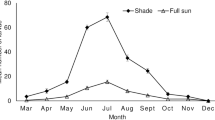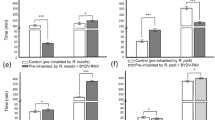Abstract
Many herbivorous insects die of pathogen infections, though the role of plant traits in promoting the persistence of these pathogens as an indirect interaction is poorly understood. We tested whether winter leaf retention of bush lupines (Lupinus arboreus) promotes the persistence of a nucleopolyhedroviruses, thereby increasing the infection risk of caterpillars (Arctia virginalis) feeding on the foliage during spring. We also investigated whether winter leaf retention reduces viral exposure of younger caterpillars that live on the ground, as leaf retention prevents contaminated leaves from reaching the ground. We surveyed winter leaf retention of 248 lupine bush canopies across twelve sites and examined how it related to caterpillar infection risk, herbivory, and inflorescence density. We also manipulated the amount of lupine litter available to young caterpillars in a feeding experiment to emulate litterfall exposure in the field. Greater retention of contaminated leaves from the previous season increased infection rates of caterpillars in early spring. Higher infection rates reduced herbivory and increased plant inflorescence density by summer. Young caterpillars exposed to less litterfall were more likely to starve to death but less likely to die from infection, further suggesting foliage mediated exposure to viruses. We speculate that longer leaf life span may be an unrecognized trait that indirectly mediates top-down control of herbivores by facilitating epizootics.





Similar content being viewed by others
Data availability
The data and code are deposited on Dryad and Zenodo respectively. Pan, Vincent; Pepi, Adam; LoPresti, Eric; Karban, Richard (2023), The Consequence of Leaf Life Span to Virus Infection of Herbivorous Insects, Dryad, Dataset, https://doi.org/10.25338/B8PD2K.
References
Anderson RM, May RM (1978) Regulation and Stability of Host-Parasite Population Interactions: I. Regulat Proces J Anim Ecol 47:219–247
Anderson RM, May RM (1980) Infectious diseases and population cycles of forest insects. Science 210(4470):658–661
Barrett JW, Brownwright AJ, Primavera MJ, Palli SR (1998) Studies of the Nucleopolyhedrovirus infection process in insects by using the green fluorescence protein as a reporter. J Virol 72(4):3377–3382
Biever KD, Hostetter DL (1985) Field persistence of Trichoplusia ni (Lepidoptera: Noctuidae) single-embedded nuclear polyhedrosis virus on cabbage foliage. Environ Entomol 14(5):579–581
Bolnick DI, Amarasekare P, Araújo MS et al (2011) Why intraspecific trait variation matters in community ecology. Trends Ecol Evol 26:183–192
Brooks ME, Kristensen K, van Benthem KJ, Magnusson A, Berg CW, Nielsen A et al (2017) GlmmTMB balances speed and flexibility among packages for zero-inflated generalized linear mixed modeling. R J 9(2):378–400
Bürkner PC (2017) brms: An R package for bayesian multilevel models using Stan. J Stat Softw 80(1):1–28
Chabot BF, Hicks DJ (1982) The ecology of leaf life spans. Annu Rev Ecol Syst 13(1):229–259
Christensen, R. H. B. (2019). ordinal: Regression models for ordinal data (Version 2019.4–25). Retrieved from https://CRAN.R-project.org/package=ordinal
Cortesero AM, Stapel JO, Lewis WJ (2000) Understanding and manipulating plant attributes to enhance biological control. Biol Control 17(1):35–49
Cory JS, Hoover K (2006) Plant-mediated effects in insect–pathogen interactions. Trends Ecol Evol 21(5):278–286
Cory JS, Myers JH (2003) The ecology and evolution of insect baculoviruses. Annu Rev Ecol Evol Syst 34:239–272
D’Amico V, Elkinton JS (1995) Rainfall effects on transmission of gypsy moth (Lepidoptera: Lymantriidae) nuclear polyhedrosis virus. Environ Entomol 24(5):1144–1149
Elliot SL, Sabelis MW, Janssen A, van der Geest LPS, Beerling EAM, Fransen J (2000) Can plants use entomopathogens as bodyguards? Ecol Lett 3(3):228–235
Faeth SH, Connor EF, Simberloff D (1981) Early leaf abscission: a neglected source of mortality for folivores. Am Nat 117(3):409–415
Gange AC, Koricheva J, Currie AF, Jaber LR, Vidal S (2019) Meta-analysis of the role of entomopathogenic and unspecialized fungal endophytes as plant bodyguards. New Phytol 223(4):2002–2010
Gasmi L, Martínez-Solís M, Frattini A, Ye M, Collado MC, Turlings TCJ et al (2019) Can herbivore-induced volatiles protect plants by increasing the herbivores’ susceptibility to natural pathogens? Appl Environ Microbiol 85(1):e01468-e1518
Grace JB, Johnson DJ, Lefcheck JS, Byrnes JEK (2018) Quantifying relative importance: computing standardized effects in models with binary outcomes. Ecosphere 9(6):e02283
Harrison S, Maron JL (1995) Impacts of defoliation by tussock moths (Orgyia vetusta) on the growth and reproduction of bush lupine (Lupinus arboreus). Ecol Entomol 20(3):223–229
Hay WT, Behle RW, Berhow MA, Miller AC, Selling GW (2020) Biopesticide synergy when combining plant flavonoids and entomopathogenic baculovirus. Sci Rep 10:6806
Hodgson DJ, Vanbergen AJ, Hartley SE, Hails RS, Cory JS (2002) Differential selection of baculovirus genotypes mediated by different species of host food plant. Ecol Lett 5(4):512–518
Hoover K, Washburn JO, Volkman LE (2000) Midgut-based resistance of Heliothis virescens to baculovirus infection mediated by phytochemicals in cotton. J Insect Physiol 46(6):999–1007
Hountondji FCC, Sabelis MW, Hanna R, Janssen A (2005) Herbivore-induced plant volatiles trigger sporulation in entomopathogenic fungi: the case of Neozygites tanajoae infecting the cassava green mite. J Chem Ecol 31(5):1003–1021
Hsieh Y-L, Linsenmair KE (2012) Seasonal dynamics of arboreal spider diversity in a temperate forest. Ecol Evol 2(4):768–777
Inglis GD, Goettel MS, Johnson DL (1993) Persistence of the entomopathogenic fungus Beauveria bassiana, on phylloplanes of crested wheatgrass and alfalfa. Biol Control 3:258–270
Inglis GD, Johnson DL, Goettel MS (1995) Effects of simulated rain on the persistence of Beauveria bassiana conidia on leaves of alfalfa and wheat. Biocontrol Sci Technol 5(3):365–370
Inyang EN, Butt TM, Beckett A, Archer S (1999) The effect of crucifer epicuticular waxes and leaf extracts on the germination and virulence of Metarhizium anisopliae conidia. Mycol Res 103(4):419–426
Kahn DM, Cornell HV (1989) Leafminers, early leaf abscission, and parasitoids: a yritrophic interaction. Ecology 70(5):1219–1226
Karban R, Grof-Tisza P, Maron JL, Holyoak M (2012) The importance of host plant limitation for caterpillars of an arctiid moth (Platyprepia virginalis) varies spatially. Ecology 93(10):2216–2226
Karban R, Grof-Tisza P, Holyoak M (2017) Wet years have more caterpillars: Interacting roles of plant litter and predation by ants. Ecology 98(9):2370–2378
Keathley CP, Harrison RL, Potter DA (2012) Baculovirus infection of the armyworm (Lepidoptera: Noctuidae) feeding on spiny- or smooth-edged grass (Festuca spp.) leaf blades. Biol Control 61:147–154
Lacey LA, Solter LF (2012) Initial handling and diagnosis of diseased invertebrates. In: Lacey LA (ed) Manual of Techniques in Invertebrate Pathology. Academic press, London
Lefcheck JS (2016) piecewiseSEM: Piecewise structural equation modelling in R for ecology, evolution, and systematics. Methods Ecol Evol 7(5):573–579
Lev-Yadun S, Halpern M (2008) External and internal spines in plants insert pathogenic microorganisms into herbivore’s tissues for defense. In: Trends MER (ed) T, vol Dijk. Nova Biomedical Books, New York, pp 155–168
Lynch RE, Lewis LC, Berry EC (1980) Application efficacy and field persistence of Bacillus thuringiensis when applied to corn for European corn borer control. J Econ Entomol 73(1):4–7
Marquis RJ (1996) Plant architecture, sectoriality and plant tolerance to herbivores. Vegetatio 127:85–97
McGuire MR, Shasha BS, Lewis LC, Nelsen TC (1994) Residual activity of granular starch-encapsulated Bacillus thuringiensis. J Econ Entomol 87(3):631–637
Mooney HA, Dunn EL (1970) Photosynthetic systems of mediterranean-climate shrubs and trees of California and Chile. Am Nat 104(939):447–453
Myers JH, Cory JS (2013) Population cycles in forest Lepidoptera revisited. Annu Rev Ecol Evol Syst 44(1):565–592
Myers JH, Cory JS (2016) Ecology and evolution of pathogens in natural populations of Lepidoptera. Evol Appl 9(1):231–247
Nilsson SG (1983) Evolution of leaf abscission times: alternative hypotheses. Oikos 40:318
Orrock J, Connolly B, Kitchen A (2017) Induced defences in plants reduce herbivory by increasing cannibalism. Nat Ecol Evol 1(8):1205–1207
Otto C, Nilsson LM (1981) Why do beech and oak trees retain leaves until spring? Oikos 37(3):387
Pearse IS, LoPresti E, Schaeffer RN, Wetzel WC, Mooney KA, Ali JG et al (2020) Generalising indirect defence and resistance of plants. Ecol Lett 23(7):1137–1152
Pepi A, Holyoak M, Karban R (2021) Altered precipitation dynamics lead to a shift in herbivore dynamical regime. Ecol Lett 24(7):1400–1407
Pepi A, Pan V, Rutkowski D, Mase V, Karban R (2022) Influence of delayed density and ultraviolet radiation on caterpillar baculovirus infection and mortality. J Anim Ecol 91(11):2192–2202
Pritchard IM, James R (1984) Leaf fall as a source of leaf miner mortality. Oecologia 64(1):140–141
Pritzkow S, Morales R, Moda F, Khan U, Telling GC, Hoover E et al (2015) Grass plants bind, retain, uptake and transport infectious prions. Cell Rep 11(8):1168–1175
R Core Team. (2020). R: A language and environment for statistical computing. Vienna, Austria: R Foundation for Statistical Computing. Retrieved from https://www.r-project.org/
Raymond B, Hartley SE, Cory JS, Hails RS (2005) The role of food plant and pathogen-induced behaviour in the persistence of a nucleopolyhedrovirus. J Invertebr Pathol 88(1):49–57
Rosa E, Woestmann L, Biere A, Saastamoinen M (2018) A plant pathogen modulates the effects of secondary metabolites on the performance and immune function of an insect herbivore. Oikos 127(10):1539–1549
Shikano I (2017) Evolutionary ecology of multitrophic interactions between plants, insect herbivores and entomopathogens. J Chem Ecol 43(6):586–598
Shikano I, Shumaker KL, Peiffer M, Felton GW, Hoover K (2017) Plant-mediated effects on an insect–pathogen interaction vary with intraspecific genetic variation in plant defences. Oecologia 183(4):1121–1134
Shikano I, McCarthy E, Hayes-Plazolles N, Slavicek JM, Hoover K (2018) Jasmonic acid-induced plant defenses delay caterpillar developmental resistance to a baculovirus: Slow-growth, high-mortality hypothesis in plant–insect–pathogen interactions. J Invertebr Pathol 158:16–23
Shipley B (2009) Confirmatory path analysis in a generalized multilevel context. Ecology 90(2):363–368
Stiling P, Simberloff D (1989) Leaf Abscission: Induced Defense against Pests or Response to Damage? Oikos 55(1):43–49
Therneau, T. M. (2020). survival: Survival Analysis (Version 3.2–7). Retrieved from https://CRAN.R-project.org/package=survival
Vega F, Kaya H (2012) Insect Pathology, 2nd edn. Academic Press, San Diego, CA
Warton DI, Hui FKC (2011) The arcsine is asinine: the analysis of proportions in ecology. Ecology 92(1):3–10
Williams T, Virto C, Murillo R, Caballero P (2017) Covert Infection of Insects by Baculoviruses. Front Microbiol 8:1337
Wright IJ, Reich PB, Westoby M, Ackerly DD, Baruch Z, Bongers F et al (2004) The worldwide leaf economics spectrum. Nature 428(6985):821
Yamazaki K, Sugiura S (2008) Deer predation on leaf miners via leaf abscission. Sci Nat 95(3):263–268
Zhao X, Lynch JG Jr, Chen Q (2010) Reconsidering baron and kenny: myths and truths about mediation analysis. J Consum Res 37:197–206
Acknowledgements
We thank Harry Kaya, Danielle Rutkowski, Vinay Mase, Michael Turelli, and Jenny Cory for helping with the identification of the virus, Neal Williams for sharing microscope equipment and freezer, Jay Rosenheim for sharing incubators and lab space, Claire Beck and Jasmine Daragahi for help with rearing caterpillars, Jackie Sones for aiding access to the Bodega Marine Reserve, the joint-insect ecology lab group at UC Davis for providing feedback, Hanna Kahl and Emily Meineke for commenting on our manuscript, and the anonymous reviewers for providing constructive comments.
Funding
VSP, AP, and RK were funded by NSF-LTREB (1456225) and an NSF-REU supplement (DEB-2018169). EFL was funded by start-up funds from Oklahoma State University.
Author information
Authors and Affiliations
Contributions
VSP, AP, and RK conceived the study and collected the data. VSP and AP conducted the analysis. VSP wrote the manuscript. AP, EFL, and RK provided editorial support. All authors contributed critically to the drafts and approved final publication.
Corresponding author
Ethics declarations
Conflict of interest
We declare no conflict of interest.
Additional information
Communicated by Caroline Müller.
Supplementary Information
Below is the link to the electronic supplementary material.
Rights and permissions
Springer Nature or its licensor (e.g. a society or other partner) holds exclusive rights to this article under a publishing agreement with the author(s) or other rightsholder(s); author self-archiving of the accepted manuscript version of this article is solely governed by the terms of such publishing agreement and applicable law.
About this article
Cite this article
Pan, V.S., Pepi, A., LoPresti, E.F. et al. The consequence of leaf life span to virus infection of herbivorous insects. Oecologia 201, 449–459 (2023). https://doi.org/10.1007/s00442-023-05325-w
Received:
Accepted:
Published:
Issue Date:
DOI: https://doi.org/10.1007/s00442-023-05325-w




